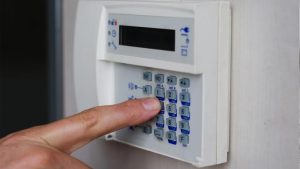Making Your Home Burglar-Resistant
 Courtesy of InterNACHI
Courtesy of InterNACHI
By Nick Gromicko and Kenton Shepard
There are a number of measures that homeowners can take to ensure that their homes are not attractive to burglars. If clients are concerned about break-ins, inspectors can pass on to them basic strategies for burglar-proofing their homes.
Some interesting statistics concerning break-ins in the United States:
- InterNACHI estimates that theft makes up more than three-quarters of all reported crime.
- In 2005, law enforcement agencies reported more than 2 million burglary offenses.
According to a survey, burglars enter homes through the following locations:
- 81% enter through the first floor;
- 34% of burglars enter through the front door;
- 23% enter through a first-floor window;
- 22% enter through the back door
- 9% enter through the garage;
- 4% enter through the basement;
- 4% enter through an unlocked entrance;
- 2% enter through a storage area; and
- 2% enter anywhere on the second floor.
Some interesting statistics (2002) concerning break-ins in Canada:
- The burglary rate in Canada (877 per 100,000 people) is seven times higher than that of the country with the fewest break-ins, Norway.
- The burglary rate in Canada is slightly higher than that of the United States (746 per 100,000 people) but significantly less than the burglary rate in Australia (2,275 per 100,000 people).
Exterior Doors
- Doors should be made of steel or solid-core wood construction. Hollow-core wood doors are more easily broken than heavy, solid-core doors.
- Doors should be free of signs of rot, cracks and warping.
- Doors should be protected by quality deadbolt locks. Chain locks are not adequate substitutes for deadbolt locks, although chain locks may be used as additional protection.
- If a mail slot is present, it should be equipped with a cage or box. Mail slots that are not equipped with cages or boxes have been used by burglars to enter homes. Burglars can insert a contraption made of wire and cord into the mail slot and use it to open the lock from the inside, if no box or cage is present.
- If a door is equipped with glass panes, they should be installed far from the lock. Otherwise, burglars can smash the glass and reach through the door to unlock the door.
- Spare keys should not be hidden in obvious locations. Burglars are very good at finding keys that homeowners believe are cleverly hidden. The best place for a spare key is in the house of a trusted neighbor. If keys must be hidden near the door, they should not be placed in obvious locations, such as under a doormat, rock or planter.
- A peephole can be installed in doors so homeowners can see who is on their doorstep before they open the door.
- Clients should consider installing bump-resistant locks on their doors. “Bumping” is a technique developed recently that can open almost any standard lock with less effort than is required by lock-picking. This technique uses “bump keys,” which are normal keys with slight modifications. Lock companies such as Schlage, Primus and Medeco manufacture a number of locks that offer some bump-resistance.
Pet Doors
- Pet doors can be used by burglars to enter homes. Some burglars have reached through pet doors in order to unlock the door. It is advisable to not have a pet door, but if one is necessary, it should be as small as possible and installed far from the lock.
- A crafty burglar may convince or coerce a small child to crawl through a pet door and unlock the door. Also, some burglars are children.
- Electronic pet doors are available that open only when the pet, equipped with a signaling device in their collar, approaches the door. These doors are designed to keep stray animals out of the home, and may provide protection against burglars, as well.
Sliding Glass Doors
- They should be equipped with locks on their tops and bottoms.
- They should not be able to be lifted from their frames.
- A cut-off broom handle, or a similar device, can be laid into the door track to prevent it from being opened.
Illumination
- Lights should be installed on the exterior of all four sides of the house. Burglars prefer darkness so they cannot be seen by neighbors or passersby.
- When building occupants are not home, a few lights should be left on.
- It is helpful to install exterior lights that are activated by motion sensors. Burglars that are suddenly illuminated may flee.
Windows
- All windows should be composed of strong glass, such as laminated glass, and be in good operating order.
- They can be installed with bars, grilles, grates or heavy-duty wire screening. Barred windows must be equipped with a quick-release mechanism so occupants can quickly escape during a fire.
- Windows should not be hidden by landscaping or structures. If landscaping or structures cannot be moved, lighting can be installed around the windows.
Landscaping and Yard
- Shrubs and trees should not obscure the view of entrances. Shielded entrances can provide cover for burglars while they attempt to enter the residence.
- Fences are helpful burglar deterrents, although they should not be difficult to see through.
While the House Is Vacant
- A loud radio can be used to make burglars think someone is home. Timers can be used to activate radios and lights to make the home seem occupied.
- A car should always be parked in the driveway. A neighbor’s car can be parked there so that it appears as if someone is home.
- The lawn should be cut regularly. Uncut grass is a clue that no one is home.
Other Tips
- Dogs are excellent burglar deterrents. For clients who cannot own dogs, they can place “Beware of Dog” signs around the yard for nearly the same effect.
- If no security system is installed, the client can post security alarm stickers around the yard.
In summary, there are a number of tactics that inspectors can pass on to their clients that will help safeguard their homes from break-ins.
